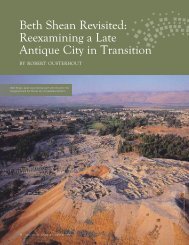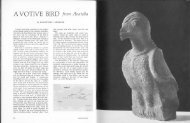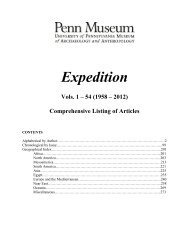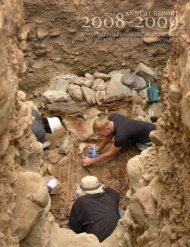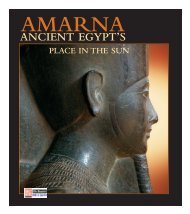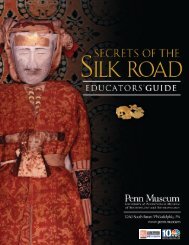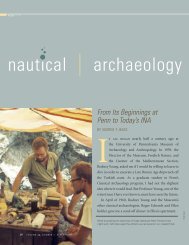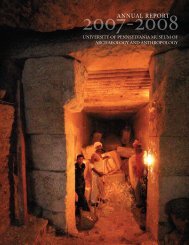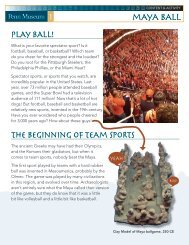butrint Putting Together a City's History by Studying Its Walls
butrint Putting Together a City's History by Studying Its Walls
butrint Putting Together a City's History by Studying Its Walls
You also want an ePaper? Increase the reach of your titles
YUMPU automatically turns print PDFs into web optimized ePapers that Google loves.
The Butrint Foundation<br />
puzzles and pieces<br />
“You like a good puzzle, don’t you?” These were the words<br />
with which Richard Hodges, the Scientific Director of the<br />
Butrint Foundation, began my first tour of the fortifications<br />
of Butrint. Like most archaeologists, I immediately answered<br />
“yes.” About two hours later, I realized that what he should<br />
have asked me was whether I liked ten good puzzles, with<br />
some of the pieces missing, all of the rest mixed together, and<br />
only a few scattered and torn pieces of a box top to guide me.<br />
<strong>Studying</strong> the various bits of wall and fortification at Butrint<br />
in order to piece together their history has proven to be just<br />
such an exercise. Although I might not have answered him as<br />
quickly had I known this, in the end the task proved both ten<br />
times as interesting and ten times as rewarding. By examining<br />
the various building phases of Butrint’s fortifications, it<br />
became possible to tell quite an interesting story about the<br />
walls that surround the site and how they both determined<br />
and reflected where the inhabitants entered the city and what<br />
parts of it they used over time.<br />
Known in the past as Buthrotum, Butrint is located in<br />
Albania near the border separating that country from Greece.<br />
Situated on a promontory at the edge of a large saltwater lake,<br />
it provides visitors with breathtaking views of portions of the<br />
lake and surrounding hills, the Straits of Corfu, and the channel<br />
and marshlands that connect them. These views make a<br />
visit to the site unforgettable.<br />
In the 1990s, however, this scenic setting nearly led to<br />
the area’s demise. When Albania’s communist government<br />
was forced to resign in 1991, and the country emerged from<br />
30 years of self-imposed and devastating isolation, developers<br />
began to gaze hungrily on the site and its surrounding<br />
landscape. It is largely through the efforts of the Butrint<br />
Foundation, and its main backers, Lord Rothschild and Lord<br />
Sainsbury of Preston Candover, that the site was preserved<br />
from development. Butrint has since become further protected<br />
as a UNESCO World Heritage Site, and the area around<br />
it is also now preserved as part of a national park.<br />
Scientific investigations at the site began in earnest in 1994<br />
when the Butrint Foundation partnered with the Albanian<br />
Institute of Archaeology to initiate a project examining the<br />
Byzantine phase of the city. As part of this project, an initial<br />
survey of the walls was completed, which served as the foundation<br />
for the present study. Most important was the identification<br />
of a number of major phases or episodes of construction<br />
including two that were thought to have occurred during the<br />
The World Heritage site of Butrint is located near the southern border<br />
of present-day Albania. The site, along with much of the coast, is visible<br />
from certain parts of Corfu. An hour and a half boat ride from the island,<br />
followed <strong>by</strong> a short car ride from the Albanian port of Saranda, is still the<br />
most convenient way for Westerners to visit the site.<br />
Middle Ages. Additional excavations and projects, including<br />
the work described here, have started to examine other phases<br />
of the site’s 3,000-year history as well. Throughout, archaeological,<br />
historical, and environmental investigations at the site<br />
have been based on an integrative approach that focuses not<br />
only on architecture and artifacts but also on the landscape<br />
setting and immediate environs. In addition, work has been<br />
guided <strong>by</strong> the recognition of just how much modern-day decisions<br />
can affect this treasure from the past, and <strong>by</strong> the practice<br />
of integrating conservation/preservation and presentation<br />
to the public into the program of excavation and study. As<br />
a result of these past and continuing efforts, Butrint thrives<br />
today as a popular tourist destination, and our knowledge and<br />
understanding of the site continue to grow.<br />
www.penn.museum/expedition 11




